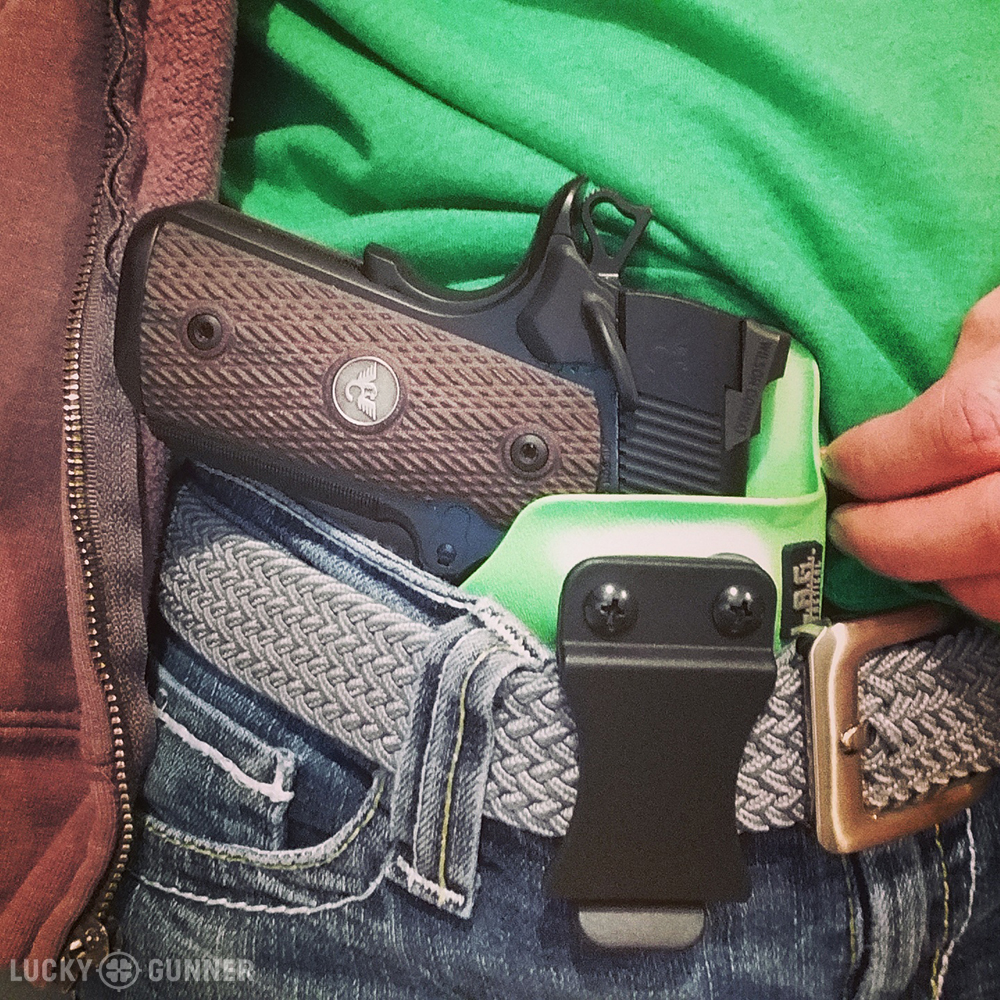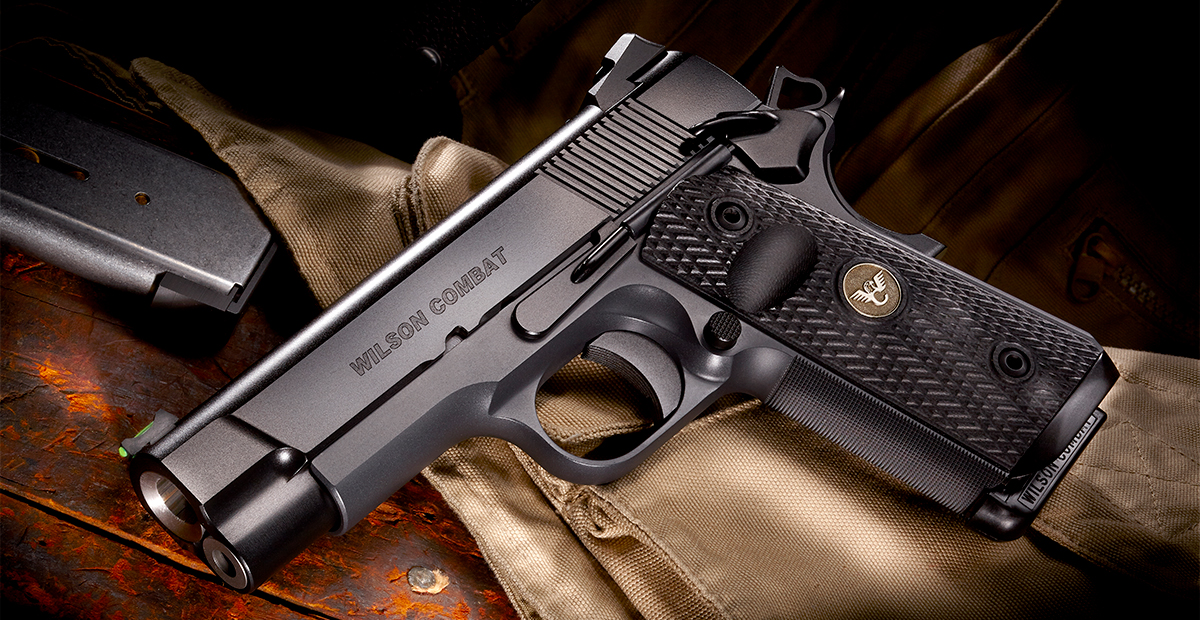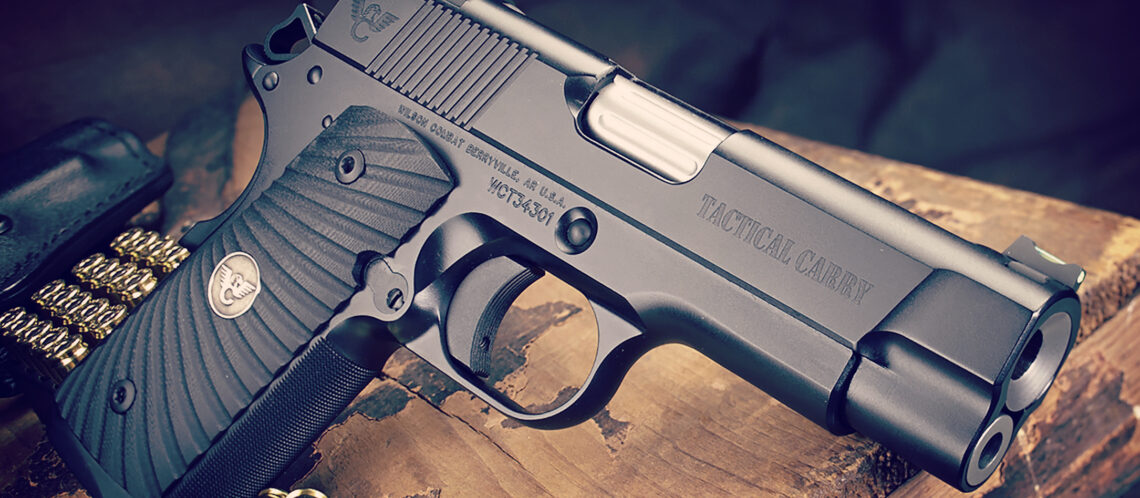The first gun I ever purchased was a 1911. I bought it to carry for self-defense. I told my husband I would only carry a gun if I picked it out myself, and my requirements were very specific. The gun had to be metal and semi-automatic with an external safety device of some sort and a light trigger. It had to be relatively small to fit my wardrobe and hand-size, and I insisted that the caliber start with 4.
I was new to firearms at the time and, as I look back on that first purchase, I smile a bit fondly on all the things I didn’t know. My requirements were based on nothing more than ignorant guesswork and a mild rebellion against the store clerks who consistently tried shoving J-frame revolvers in my hands. Ultimately, I chose the 1911 because I thought it was prettier than other guns I’d seen, and I was somewhat familiar with its operation because my brother allowed me to shoot his when we were kids.
Within three years of that purchase, I had taken training classes, gained more experience, and started practicing weekly. I began to learn what fit me and what didn’t, and what I needed in a carry gun changed. I ended up moving away from the 1911 for concealed carry and never anticipated I would go back, though I still thoroughly enjoyed shooting them.
A decade of training, carrying, and experience came and went, and I suddenly found myself in the unique position of being asked if I wanted to try a 90-day trial evaluation of a Wilson Combat Tactical Carry Compact in 9mm. While I’d written off 1911s as carry guns years before, I still accepted the offer from Wilson Combat with this question on my mind: Could I ever see myself carrying a 1911 again for self-defense?
The Wilson Combat Tactical Carry Compact
When the Tactical Carry Compact arrived at my local FFL, I was giddy. I’ve owned several high-end 1911s through the years, and Wilson Combat has always been one of my favorite 1911 manufacturers. I’ve loved every gun of theirs that I’ve shot. I was excited by the prospect of shooting and carrying this gun, and everything about it looked promising. It sports a 4″ barrel on an all-steel compact frame with standard Wilson Combat G-10 grips, a one-piece Bullet Proof round-butt magazine well, and Wilson’s ArmorTuff finish. Wilson Combat was kind enough to put an ambidextrous safety on the gun before they sent it to me. They also paired the rear Battlesight with the optional Tritium front sight in place of the standard fiber optic front sight. Otherwise, the gun was completely stock. Since I planned to run this pistol through some training classes, Wilson sent six of their excellent 8-round 9mm Enhanced Tactical Magazines (ETM).

Since this was a carry gun, I was going to need a holster for it. I sent an email to my friends at LAG Tactical, and they were generous enough to donate an AIWB 1911 holster for my test. I’d recently switched from behind-the-hip holsters to appendix-inside-the-waistband (AIWB) carry and wanted to see if I could pull off carrying a 1911 in that position. While I waited for the holster to arrive, I carried behind the hip again and set off to the range to see how it felt to go back to the 1911.
Weight
Steel guns are heavy. The Tactical Carry Compact weighs in at just over two pounds fully loaded. Having carried a variety of steel 1911s in the past, I knew what I was in for and made sure to mitigate the weight issue with a proper holster and belt. For some, the weight of a steel-framed gun can be too much, and it can be a hard sell considering the lightweight and high-capacity handgun options available. For others, however, the weight mitigates recoil and is a comforting aspect to a firearm in general.
Size
For a single-stack 9mm 1911, I was initially a little disappointed with how large the gun felt in my hands. It was clear to me from the start that this firearm was meant for average size people carrying and shooting average size guns, not micro-humans like me. Had the gun been mine and not on loan, I would have immediately replaced the grip panels with something slimmer and swapped the extended magazine well mainspring housing for a standard one. While this would have negated the funneling feature of the magazine well, it would also have made the gun far more concealable on my small frame. The mag well doesn’t add much length to the grip, but when you’re 5’4” and about 100 pounds, every little bit makes a difference.

Even with my early misgivings about the grip size, the Tactical Carry Compact turned out to be nearly perfect for me. The four-inch barrel was long enough to provide a good sight radius and bullet velocity while still being comfortable when concealing. The controls were easily accessible and, despite my small hand-size and years of neglecting 1911s, I was able to pick the gun up and run it well in relatively short order.
Reliability
From our first range trip out, I noticed the gun was having some failures to return to battery–approximately two in the first 200 shots fired. A small tap on the back of the slide would fix the problem, but it was annoying enough that I contacted Wilson. My contact there explained that their small 9mm’s were pretty finely tuned for defensive ammunition and hotter loads are often needed to give the gun the slide velocity necessary to get everything moving.
Finely tuned guns, like cars, are sometimes optimized for specific ammunition to make them run well. While inconvenient for shooters who want to put any old thing in their gun, for those who demand high standard performance from their firearms, using high-quality ammunition is part of that package. I had been throwing any practice ammunition I could find into the Wilson, so it’s no surprise that some issued popped up. When I ran hotter ammunition, as suggested, the reliability issues stopped, and the Wilson began to win me over.
Accuracy
If there was one thing that made me fall in love with the Tactical Carry, it was the accuracy. Wilson Combat guarantees 1.5-inch accuracy at 25 yards from this gun, but–let’s face it–most guns out-perform their handlers. I’ve always been a fairly accurate shooter, hitting targets at 100 yards with handguns, but each handgun is different. The level of difficulty in making such shots can be compounded by attempting to steady a light gun or keeping the sights properly aligned through a long trigger press, among other things.

The Tactical Carry Compact’s weight settled easily into the hand, steadying it quickly. The short, light trigger made for very little effort in pressing off a shot, and the inherent accuracy of the firearm itself made distance shooting a pleasure. I made 25-yard head shots and 60-yard body shots with ease. At closer ranges, such as 5 or 7 yards, I got single-hole groups with very little effort.
I was getting spoiled.
Class Environment
There’s something about a shooting class that will bring out the worst in guns and gear. No matter how well a gun performs in a static environment, when shooting on the move, drawing from the holster, and dealing with performance pressure, it’s amazing to see how many guns start to exhibit issues.
I took the Tactical Carry Compact to a two-day defensive handgun class, and that’s where I ultimately decided that I really, really liked this gun. I carried it on my strong side hip, and other than the out-of-battery issues from the underpowered ammunition I was shooting, it performed to an impressive standard. If I had a single complaint in those two days, it was the capacity. When going head-to-head with other shooters on a dueling tree, I chose to shoot two guns and transition between them rather than attempt to reload the Wilson.
Despite being dropped in the mud a few times, it continued to run and perform spectacularly. The Armor Tuff finish took the abuse like a champ and was no worse for wear when the gloves came off. Going back to engaging and disengaging the manual safety was as easy as going back to driving my first car with a manual transmission. There was no perceptible delay in my ability to get hits on target or fumbling with the safety after the initial few draws from the holster.
I was expecting to love the Tactical Carry Compact right out of the box, and though it took a few months of putting nearly 2,000 rounds of ammo through it, the gun won me over in a big way. I was sad to see it go back to Wilson Combat.

All that said, for me, it wouldn’t do as a carry gun. If I were able to keep the gun, it would be a range shooter and maybe brought out for the occasional match, but that’s it. This is no fault of the Tactical Carry Compact itself. It is just not compatible with my delicate features for regular concealment without going back to behind-the-hip method of carry that I gave up over a year ago.
However, for those interested in a high-end 9mm 1911 carry gun and don’t mind the weight and capacity, the Tactical Carry Compact is something to consider. Wilson Combat is known for their reputation for outstanding firearms, and they stand behind them with exceptional customer service. They certainly delivered with the Tactical Carry Compact, even if it wasn’t the gun I would have chosen for myself. It is very concealable for an average-sized adult, and the mild recoil in the steel frame make for a soft and fast shooting package worthy of the name.

